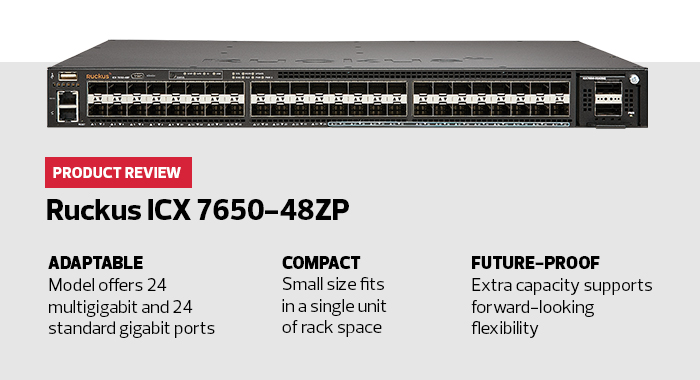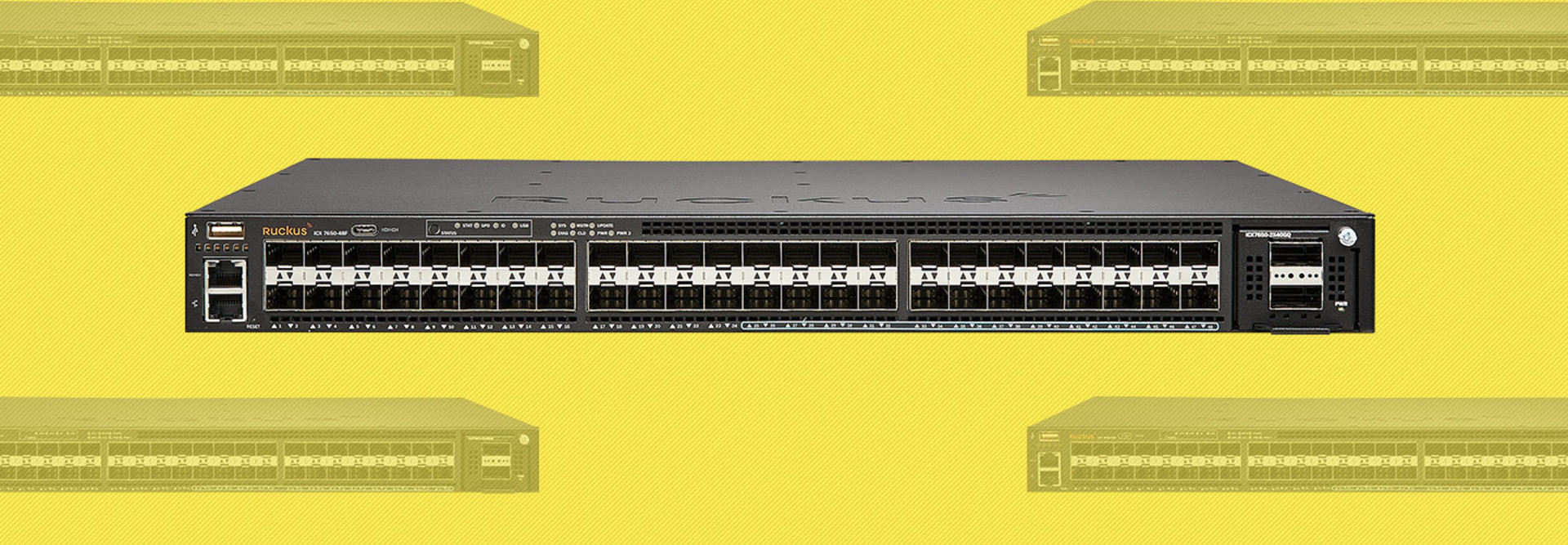Review: Ruckus’ ICX 7650-48ZP Switch Helps Future Proof Your Network
Network connectivity is critically important for both students and staff, yet most institutions refresh their network and wireless infrastructure only once every eight to 10 years. With new wireless technology hitting the market roughly every three years, quite a few colleges may be lagging behind the curve.
One solution is the Ruckus ICX 7650 switch, which comes loaded with extra features and capacity that can help colleges stay relevant and supportive of new technology as it advances — even if they don’t require that capacity initially. Admins generally use the ICX7650-48ZP model, which boasts the highest capacity in the line, as an access-level switch to onboard new devices and users.
Support for All Current and Future Devices
All the new switches, including the ICX7650-48ZP, feature a thin design that fits in a single rack slot. Users can chain together up to 12 ICX switches for increased capacity without requiring any special or proprietary cables.
The ICX 7650-48ZP comes standard with 24 ports of multigigabit (IEEE 802.3bz) Ethernet ports and 24 ports for standard gigabit Ethernet. The gigabit ports support standard PoE+ devices, while the multigigabit ports can drive devices with power requirements up to 90 watts from a 1,500-watt overall pool.
Even the pending 802.11ax wireless access ports should only require 45 to 60 watts of power at most. That said, the idea is to have the ICX support today’s technology, the next generation’s and the one after that.

Ruckus has also built in features to help the ICX support mission-critical applications, such as connectivity inside lecture halls or science buildings that house ongoing experiments. Every ICX switch has two hot-swappable cooling fans and two power supplies. Should one go down, the ICX will keep working while a replacement is obtained.
An easy-to-use management console gives users full control over everything from connectivity to PoE levels. Together, these attributes make the ICX 7650-48ZP a great fire-and-forget-it network backbone — one that should be just as useful on campus years from now as it is today.
Ports Deliver Maximum Power to Connected Devices
One of the reasons the Ruckus ICX 7650-48ZP access-level switch is so future-proof is that half of its ports go well beyond the standard Power over Ethernet or even PoE+ standards, offering a full 90 watts of power to connected devices.
It doesn’t take much math to determine that, with a maximum power pool of 1,500 watts, you won’t be able to have every device pulling down 90 watts. In fact, if every connected PoE device needed 90 watts of power, your power well would run dry after only 16 ports were connected, and that wouldn’t even take into account anything running on the 24 PoE+ ports.
However, almost nothing today requires that much power delivered over an Ethernet cable. I’ve tested network surveillance cameras that needed only about 20 watts of power, and even the most advanced, power-hungry 802.11n wireless hubs require about 40 watts. There is some speculation that some of the pending 802.11ax access points might require as much as 60 watts PoE, but even that is a far cry from 90.
My lab has a few test devices that can pull as much PoE power as needed and measure that flow for accuracy. I connected four phantom devices to the ICX 7650-48ZP and had them draw 90 watts of power. I also connected several wireless hubs, an LED light rack, two surveillance cameras and a drone. At the same time, an avalanche and reflector device simulated traffic through the switch, with 100 simultaneous users.
The total power draw was 583 watts, which the ICX 7650-48ZP had no trouble supplying. Even going from a zero PoE draw to 583 in just a few seconds had no effect on throughput or network operations. And after an hour of running at that level of PoE, the switch was neither measurably hotter nor running any louder than before.
It might be a few years before there are enough devices to reliably test a full load of 90-watt devices on the ICX 7650-48ZP. Given how well it did with a very dense power load, it’s a safe bet that future devices won’t be overly troublesome.
Ruckus ICX7650-48ZP
Maximum Switching Capacity: 1.128 Tbps
Maximum Ports: 48
Aggregated Stacking Bandwidth:2.4 Tbps
Maximum Switches per Stack:12
Supported Power over Ethernet: 90 watts PoE/PoE+/802.3bt









